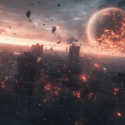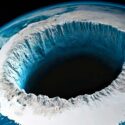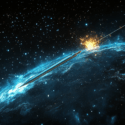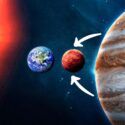Let me take you on a wild ride to the very edges of our Universe. But it won’t be as simple as traveling through space. Because the edges that we’re talking about aren’t in space. They’re in time.
Why is the Universe that we see a Universe of the past? How far back into the Universe’s history could you go? And what would you see in the young Universe?
The Universe doesn’t have the kind of edge you might imagine. But there is a limit to how far into outer space we can see from Earth. And the part that we can see is called the observable Universe. This observable Universe does have an edge.
But it’s not a border in space. It’s a border in time. When we look out into space, we see the stars and galaxies from the past. And the deeper into the Universe we look, the farther back in time we see.
So join me on this mind-bending trip back in time to the very beginning of our Universe. It seems pretty weird that our telescopes look into the past. But it all has to do with how light travels.
Take the Sun, for example. It’s located about 150 million km (93 million mi) from Earth. And light travels at 300,000 km/s (186,282 mi/s).
So if you look outside, the light that you see was emitted from the Sun eight minutes ago. The further an object is from Earth, the longer it takes for its light to reach you. And that’s why, when we look into space, we’re looking backward in time.
Just how far back in time is that observable edge? Well, using the Hubble Space Telescope, we’ve been able to look back 13 billion years. We can see what the Universe looked like a mere 400 to 800 million years after the Big Bang.
But enough about telescopes. Let’s start teleporting. Our first stop would be 19 billion light-years away. At this point, the visible Universe would be 3 billion years old.
The Earth wouldn’t exist yet, but stars would be bursting into existence. They would be forming 20-30 times faster than they are today.
And there would be vast amounts of radiation as active supermassive black holes feasted on the surrounding matter.
Next, we’d teleport to a visible point 27 billion light-years away. The Universe would be 1 billion years old.
Here, fewer stars would be forming. Heavy elements would be rare at this point in time, so there would be no rocky, Earth-like planets yet. Galaxies would be less developed and filled with young stars. And everything would be bathed in a hot cosmic microwave background.
We’d reach the first edge when the Universe is 700 to 800 million years old. This is called the edge of transparency. At this stage, the Universe would be filled with hot, opaque, glowing gas. Only infrared telescopes can see past the edge of transparency.
The second edge we would reach is 31 billion light-years away from Earth. And it’s called the age of reionization.
The Universe would be 550 million years old. The gas that we encountered before would be gone, and the Universe would be mostly transparent.
The most distant galaxy ever observed is 32 billion light-years from Earth. There, the Universe would only be 400 million years old.
That is the farthest our telescopes can see. But there are indirect signs that stars formed earlier, giving us a view deeper into space and time.
If we teleported to a time when the Universe was only 50 to 100 million years old, you’d see the very first stars forming. Before this, the Universe was dark.
But if we went further back into time, you’d witness another visible edge. At the young age of 3 million years old, the Universe would be bathed in radiation so hot, you could see it with your naked eye. It would be like a red glow.
And the furthest point we’d teleport to would be 46 billion light-years away. This would be the last and most significant edge of the Universe, the ultra-energetic stage of the Big Bang.
We call this an edge because we can’t see further than this point, but it’s not the physical edge of the Universe. So is there a solid edge out there that you could peek over?
No, and here’s why. The Universe is constantly expanding, but it’s not expanding into anything. It’s more like the surface of a ball. If you walked along the surface of a giant ball, you’d end up where you started. But you’d never encounter a physical edge.
Sources
- “Universe is 13.8 billion years old, scientists confirm” Doyle Rice. 2021. usatoday.com.
- “How Old Is The Sun? | NASA Space Place – NASA Science For Kids”. 2021. spaceplace.nasa.gov.
- “What is the Big Bang Theory?”. Matt Williams. 2021. phys.org.
- “Milky Way belongs to supercluster of galaxies named Laniakea”. Sciworthy.
- “When you look up, how far back in time do you see?”. 2018. The Conversation.
- “It Took Centuries, But We Now Know The Size Of The Universe”. Baraniuk, Chris. 2021. bbc.com.



























